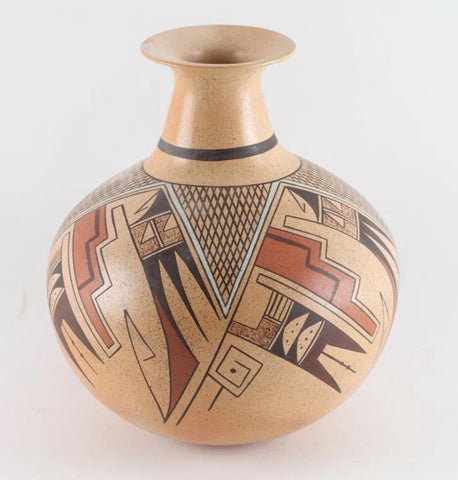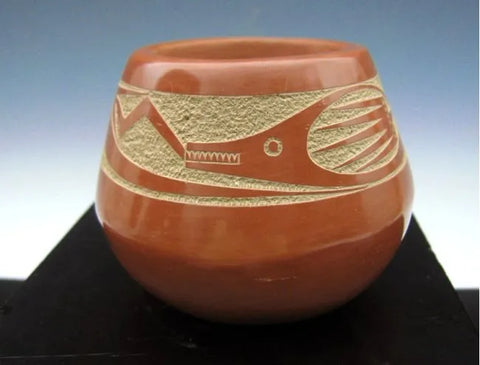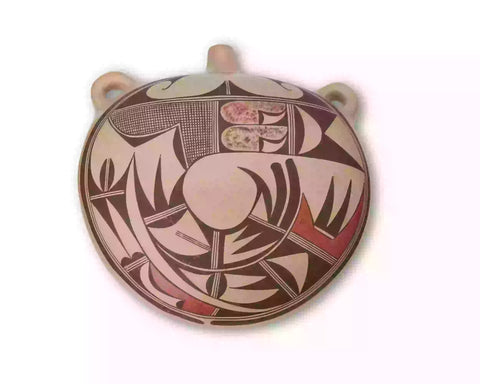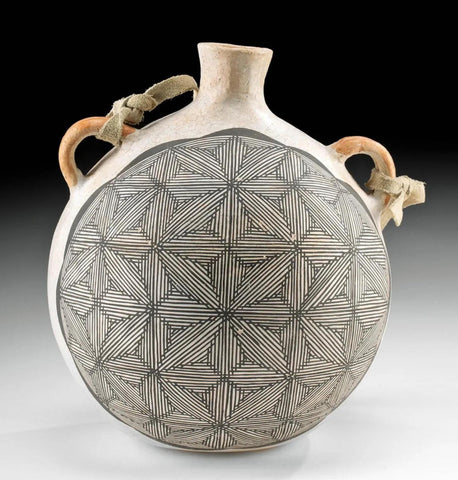Home
>
Native American Indian Pottery
>
Native American, Prehistoric, Anasazi Corrugated Redware Bowl, CA 1000-1600 AD, #1498 SOLD
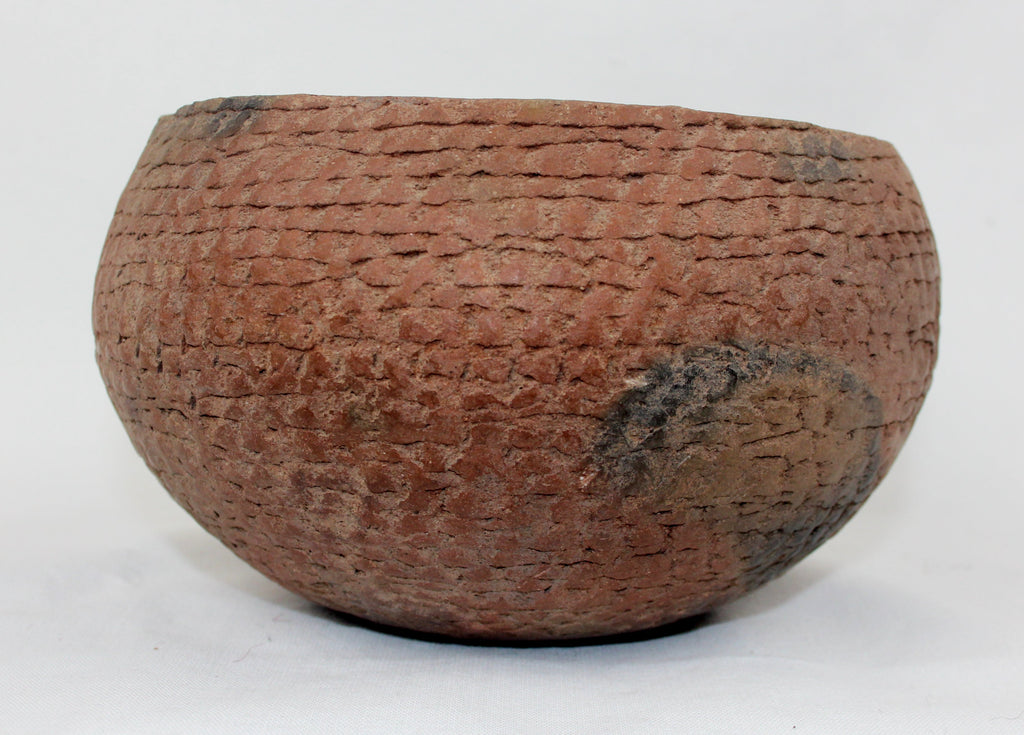
Native American, Prehistoric, Anasazi Corrugated Redware Bowl, CA 1000-1600 AD, #1498 SOLD
$ 500.00
Native American, Prehistoric, Anasazi Corrugated Redware Bowl, CA 1000-1600 AD, #1498
Description: #1498 Native American, Prehistoric, Anasazi Corrugated Redware Bowl, CA 1000-1600 AD. Classic corrugated redware extra-fine bowl with exceptional patina. Prehistoric
Condition: Very good condition.
Dimensions: 3.5" x 6.0"
Some background on the Anasazi:
Ancestral Pueblo culture, also called Anasazi, prehistoric Native American civilization that existed from approximately AD 1000 to 1600, centering generally on the area where the boundaries of what are now the U.S. states of Arizona, New Mexico, Colorado, and Utah intersect. The descendants of the Ancestral Pueblo comprise the modern Pueblo tribes, including the Hopi, Zuni, Acoma, and Laguna. As farmers, Ancestral Pueblo peoples and their nomadic neighbors were often mutually hostile; this is the source of the term Anasazi, a Navajo word meaning “ancestors of the enemy,” which once served as the customary scientific name for this group.
Ancestral Pueblo prehistory is typically divided into six developmental periods. The periods and their approximate dates are Late Basket maker II (AD 100–500), Basket maker III (500–750), Pueblo I (750–950), Pueblo II (950–1150), Pueblo III (1150–1300), and Pueblo IV (1300–1600). When the first cultural time lines of the American Southwest were created in the early 20th century, scientists included a Basket maker I stage. They created this hypothetical period in anticipation of finding evidence for the earliest stages of the transition from hunting and gathering economies to fully agricultural societies. By the late 20th century archaeologists had concluded that Basket maker II peoples had actually filled that role. Rather than renaming Basket maker II and III to reflect this understanding of the evidence, Basket maker I was generally eliminated from regional time lines, although some scientific discussions about its role in regional chronologies continued in the early 21st century.
The Basket maker II and III periods are named for the fine basketry often found in the habitation sites of these people. Like other Archaic cultures in North America, the Basket maker II economy combined hunting, gathering wild plant foods, and some corn (maize) cultivation. These people typically lived in caves or in shallow pit houses constructed in the open. They also created pits in the ground that were used for food storage. Storage pits were often lined and capped in order to aid in food preservation, to prevent vermin infestation, and to prevent injuries.
The Basket maker III period (also called the Modified Basket maker period) is marked by the increasing importance of agriculture, including the introduction of bean crops and the domestication of turkeys. To support their agricultural pursuits and increasing population, the people built irrigation structures such as reservoirs and check dams, low stone walls used to slow the flow of rivulets and streams in an area, increasing soil moisture and decreasing erosion. Hunting and gathering continued, although in supplementary roles; an increasingly sedentary way of life coincided with the widespread use of pottery. Basket maker III people resided in relatively deep semisubterranean houses that were located in caves or on mesa tops.
During the Pueblo I period most building shifted above ground, and a number of very large communities were built, some with more than 100 adjoining rooms. Stone masonry began to be used, and kivas, the underground circular chambers used henceforth primarily for ceremonial purposes, became important community features. Cotton was introduced as an agricultural product, pottery assumed a greater variety of shapes, finishes, and decorations, and basketry became less common. Throughout this period, the area of Ancestral Pueblo occupation continued to expand, and new communities began to be built in canyons in addition to the traditional mesa-top locations.
While many Pueblo I communities were quite large, the Pueblo II period is characterized by a greater diversity of settlements; small hamlets and villages began to be built in addition to the large communities, or “great houses,” that were typical of Pueblo I. Kivas also became more diverse; some were built in towers, while others were built much larger than before.
The Pueblo III period was the time of the great cliff dwellings. These villages were built in sheltered recesses in the faces of cliffs but otherwise differed little from the masonry or adobe houses and villages built previously. Large, freestanding apartment-like structures were also built along canyons or mesa walls. In all of these settings, dwellings often consisted of two, three, or even four stories, generally built in stepped-back fashion so that the roofs of the lower rooms served as terraces for the rooms above. These structures had 20 to as many as 1,000 rooms. The population became concentrated in these large communities, and many smaller villages and hamlets were abandoned. Agriculture continued to be the main economic activity, and craftsmanship in pottery and weaving achieved its finest quality during this period.
Ancestral Pueblo people abandoned their communities by about AD 1300, the time that marks the beginning of the fourth Pueblo period. It is believed that a convergence of cultural and environmental factors caused this to occur. The Great Drought (1276–99) probably caused massive crop failure; rainfall continued to be sparse and unpredictable until approximately 1450. At the same time, and perhaps in relation to the Great Drought’s impact on the availability of wild foods, conflicts increased between the Ancestral Pueblo and ancestral Navajo and Apache groups. During the Pueblo IV period, the Ancestral Pueblo moved to the south and the east, building new communities in places where gravity-based irrigation works could be built, including the White Mountains of what is now Arizona, as well as the Rio Grande valley.
Although some new villages were even larger than those of Pueblo III, they tended to be cruder in layout and construction than their earlier counterparts; stone was used less often, and in some cases construction materials consisted wholly of adobe. The production of fine pottery continued to flourish and develop, however, as did weaving.
The history of the modern Pueblo tribes is usually dated from approximately 1600 onward, as Spanish colonial occupation of the North American Southwest began in 1598. The Spanish mandate was to Christianize the indigenous population and to extract tribute for the crown, and violence was often used in order to gain these ends. This caused deep hostility among the Pueblo peoples, who coordinated a successful regional revolt in 1680; they remained free of Spanish authority for 14 years. By the early 18th century, epidemic disease and colonial violence had reduced the indigenous population and the number of Pueblo settlements, which had fallen from approximately 75 to between 25 and 30 communities. Despite these changes, many aspects of Ancestral Pueblo culture persist in contemporary Pueblo religions, languages, agricultural practices, and craft production.
Pueblo descendants numbered some 75,000 individuals in the early 21st century. (Source: Encyclopedia Britannica)
Description: #1498 Native American, Prehistoric, Anasazi Corrugated Redware Bowl, CA 1000-1600 AD. Classic corrugated redware extra-fine bowl with exceptional patina. Prehistoric
Condition: Very good condition.
Dimensions: 3.5" x 6.0"
Some background on the Anasazi:
Ancestral Pueblo culture, also called Anasazi, prehistoric Native American civilization that existed from approximately AD 1000 to 1600, centering generally on the area where the boundaries of what are now the U.S. states of Arizona, New Mexico, Colorado, and Utah intersect. The descendants of the Ancestral Pueblo comprise the modern Pueblo tribes, including the Hopi, Zuni, Acoma, and Laguna. As farmers, Ancestral Pueblo peoples and their nomadic neighbors were often mutually hostile; this is the source of the term Anasazi, a Navajo word meaning “ancestors of the enemy,” which once served as the customary scientific name for this group.
Ancestral Pueblo prehistory is typically divided into six developmental periods. The periods and their approximate dates are Late Basket maker II (AD 100–500), Basket maker III (500–750), Pueblo I (750–950), Pueblo II (950–1150), Pueblo III (1150–1300), and Pueblo IV (1300–1600). When the first cultural time lines of the American Southwest were created in the early 20th century, scientists included a Basket maker I stage. They created this hypothetical period in anticipation of finding evidence for the earliest stages of the transition from hunting and gathering economies to fully agricultural societies. By the late 20th century archaeologists had concluded that Basket maker II peoples had actually filled that role. Rather than renaming Basket maker II and III to reflect this understanding of the evidence, Basket maker I was generally eliminated from regional time lines, although some scientific discussions about its role in regional chronologies continued in the early 21st century.
The Basket maker II and III periods are named for the fine basketry often found in the habitation sites of these people. Like other Archaic cultures in North America, the Basket maker II economy combined hunting, gathering wild plant foods, and some corn (maize) cultivation. These people typically lived in caves or in shallow pit houses constructed in the open. They also created pits in the ground that were used for food storage. Storage pits were often lined and capped in order to aid in food preservation, to prevent vermin infestation, and to prevent injuries.
The Basket maker III period (also called the Modified Basket maker period) is marked by the increasing importance of agriculture, including the introduction of bean crops and the domestication of turkeys. To support their agricultural pursuits and increasing population, the people built irrigation structures such as reservoirs and check dams, low stone walls used to slow the flow of rivulets and streams in an area, increasing soil moisture and decreasing erosion. Hunting and gathering continued, although in supplementary roles; an increasingly sedentary way of life coincided with the widespread use of pottery. Basket maker III people resided in relatively deep semisubterranean houses that were located in caves or on mesa tops.
During the Pueblo I period most building shifted above ground, and a number of very large communities were built, some with more than 100 adjoining rooms. Stone masonry began to be used, and kivas, the underground circular chambers used henceforth primarily for ceremonial purposes, became important community features. Cotton was introduced as an agricultural product, pottery assumed a greater variety of shapes, finishes, and decorations, and basketry became less common. Throughout this period, the area of Ancestral Pueblo occupation continued to expand, and new communities began to be built in canyons in addition to the traditional mesa-top locations.
While many Pueblo I communities were quite large, the Pueblo II period is characterized by a greater diversity of settlements; small hamlets and villages began to be built in addition to the large communities, or “great houses,” that were typical of Pueblo I. Kivas also became more diverse; some were built in towers, while others were built much larger than before.
The Pueblo III period was the time of the great cliff dwellings. These villages were built in sheltered recesses in the faces of cliffs but otherwise differed little from the masonry or adobe houses and villages built previously. Large, freestanding apartment-like structures were also built along canyons or mesa walls. In all of these settings, dwellings often consisted of two, three, or even four stories, generally built in stepped-back fashion so that the roofs of the lower rooms served as terraces for the rooms above. These structures had 20 to as many as 1,000 rooms. The population became concentrated in these large communities, and many smaller villages and hamlets were abandoned. Agriculture continued to be the main economic activity, and craftsmanship in pottery and weaving achieved its finest quality during this period.
Ancestral Pueblo people abandoned their communities by about AD 1300, the time that marks the beginning of the fourth Pueblo period. It is believed that a convergence of cultural and environmental factors caused this to occur. The Great Drought (1276–99) probably caused massive crop failure; rainfall continued to be sparse and unpredictable until approximately 1450. At the same time, and perhaps in relation to the Great Drought’s impact on the availability of wild foods, conflicts increased between the Ancestral Pueblo and ancestral Navajo and Apache groups. During the Pueblo IV period, the Ancestral Pueblo moved to the south and the east, building new communities in places where gravity-based irrigation works could be built, including the White Mountains of what is now Arizona, as well as the Rio Grande valley.
Although some new villages were even larger than those of Pueblo III, they tended to be cruder in layout and construction than their earlier counterparts; stone was used less often, and in some cases construction materials consisted wholly of adobe. The production of fine pottery continued to flourish and develop, however, as did weaving.
The history of the modern Pueblo tribes is usually dated from approximately 1600 onward, as Spanish colonial occupation of the North American Southwest began in 1598. The Spanish mandate was to Christianize the indigenous population and to extract tribute for the crown, and violence was often used in order to gain these ends. This caused deep hostility among the Pueblo peoples, who coordinated a successful regional revolt in 1680; they remained free of Spanish authority for 14 years. By the early 18th century, epidemic disease and colonial violence had reduced the indigenous population and the number of Pueblo settlements, which had fallen from approximately 75 to between 25 and 30 communities. Despite these changes, many aspects of Ancestral Pueblo culture persist in contemporary Pueblo religions, languages, agricultural practices, and craft production.
Pueblo descendants numbered some 75,000 individuals in the early 21st century. (Source: Encyclopedia Britannica)
Related Products
Sold out
Sold out







